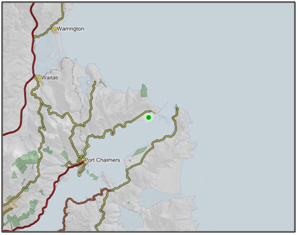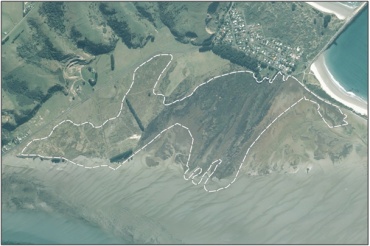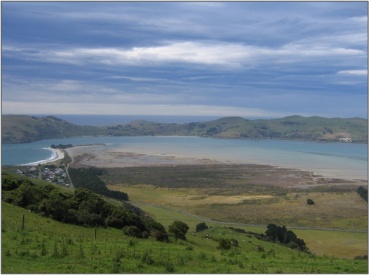- Part of Aramoana Saltmarsh is located in the coastal marine area, which is covered by the Regional Plan: Coast for Otago.
- Marsh considered to be biologically significant both as the most important habitat for wading birds, as well as the most extensive and least modified saltmarsh in Otago.9
- Birds commonly found in Aramoana Saltmarsh include migratory Eastern Bar-tailed Godwit (Limosa lapponica baueri), South Island Pied Oystercatcher (Haematopus ostralegus finschi), Pied Stilt (Himantopus himantopus), Spur-winged Plover (Vanellus miles novae hollandiae), Banded Dotterel (Charadrius bicinctus), White-faced Heron (Ardea novae hollandiae novae hollandiae), and various species of Ducks (Anatidae) and Gulls (Laridae).7
- Eighty species of moth have been recorded.7
- Listed as an Area of Significant Conservation Value in the Dunedin City District Plan. Described as buffer area (pasture) dunes and sand spit. Breeding grounds for insects and feeding grounds for many birds. The saltmarsh area above mean high water springs lies adjacent to the second largest representation of dune slacks area in New Zealand. Of international/national significance.28
-
-
-
-
-
-
-
-
-
-
-
-
-
Aramoana Saltmarsh
-
-
-
-
-
-
-
-
-
-
-
-
-
-
-
-
-
-
Aramoana Saltmarsh
Description:
Saltmarsh and flax-dominated swamp areas. 1
Type/Class:
Swamp. 2
Size:
74.5 ha.
Altitude:
0-20 m above sea level.
Approximate location:
South of Moana Street and Aramoana Road, Aramoana.
NZTM (centre point): E1420970 N4927750
Regional Plan: Water for Otago.
Schedule 9 Regionally Significant Wetland, no.4, Map F53.
Territorial Authority:
Dunedin City Council.

Recorded Values:
Value |
Description |
|---|---|
A4 |
High degree of wetland naturalness. Saltmarsh is largely intact with a complete vegetation sequence from tidal to dry land a feature which most other saltmarshes in Otago no longer retain, as the highest part of the sequence has usually been reclaimed or otherwise destroyed. There is also no Spartina spp. at Aramoana. '1','2' |
A5 |
Scarce in Otago in terms of its ecological or physical character. The saltmarsh grades into an oioi (Leptocarpus similis) and saltmarsh ribbonwood (Plagianthus divaricatus) community. Beyond the salt influence, some of the wet dune hollows (known as "slacks") contain a swamp variously dominated by the tall New Zealand flax (Phormium tenax), and by native rush and sedge communities.1 Less than 15% of swamps remain in Otago. '2' |
A6 |
Highly valued by Kai Tahu for cultural and spiritual beliefs, values and uses, including mahika kai and waahi taoka. 1 |
A1-A3, A7-A9 |
No relevant information is currently held by the ORC. |
Other Information:


References:
1 Otago Regional Council (2004) Regional Plan: Water for Otago. Published by the Otago Regional Council, Dunedin.
2. Ausseil, A.G., Newsome, P., Johnson, P, (2008) Wetland Mapping in the Otago Region. Landcare Research Contract Report prepared for the Otago Regional Council.
7. Department of Conservation (2003) Super Sites of Conservation Education- Aramoana, Published by the Department of Conserv atio, Wellington.
9. Land Information New Zealand (2004) Crown Pastoral Land Tenure Review: Matukituki Pastoral Lease. Conservation Resources Report for the Commissioner of Crown Lands. Published by Land Information New Zealand, Wellington.
28. Dunedin City Council (1999) Dunedin City District Plan. Published by the Dunedin City Council, Dunedin.
